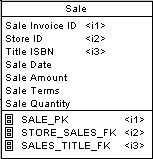

Chapter 5 Customizing the PDM Environment
To set display preferences for tables, select Tools→Display Preferences, and select the Table sub-category in the left-hand Category pane.
| Preference | Description |
|---|---|
| Columns | Displays all columns, primary key columns, or a defined number (limit) of columns depending on the selections listed below* |
| *All columns | Displays all table columns |
| *PK columns | Displays primary key columns only |
| *Key columns | Displays all key columns |
| *Limit | Displays x columns |
| Indexes | Displays all indexes defined for table columns |
| Keys | Displays all keys defined on table |
| Triggers | Displays all triggers defined for table |
| Owner | Displays name of table owner |
| Stereotype | Displays stereotype of the table. You can also display the stereotype of columns, keys, indexes, and triggers |
| Comment | Displays comment of the table. When selected, all other check boxes are deselected, except for Stereotype |
You can display information about columns in each table.
Keys and indexes are represented by indicators in the table symbol. Each key and index indicator is assigned a number. You can use these numbers to keep track of the different groups of alternate keys, foreign keys, and indexes in your model.
You can display the following column information in a table symbol:
| Preference | Displays | Example |
|---|---|---|
| Data types | Data type for each column | 
|
| Replace by domains | Domain codes for each column attached to a domain | 
|
| Domains | Domain of an attribute in the table. This display option interacts with the selection for Data types. As a result, there are four display options | See Display domain and data type for options and examples |
| Key Indicators | <pk>, <fk>, and <ak> indicators next to primary key, foreign key, and alternate key columns respectively. When the Keys preference is also selected, the key names are listed at the bottom of the table symbol | 
|
| Index indicators | <i(number )> indicator next to indexed columns. When the Indexes preference is also selected, the index names and corresponding numbers are listed at the bottom of the table symbol | 
|
| NULL/NOT NULL | Column indicator: null, not null, identity, or with default (DBMS-dependent) | 
|
![]() Displaying foreign key indicator numbers
Displaying foreign key indicator numbers
You can display foreign key numbers next to their corresponding foreign key names on the references links between the appropriate parent and child tables.
For information on displaying text with a reference symbol, see section Reference display preferences.
You can display the domain of an attribute in the symbol of a table. There are four display options available:
| Preference | Displays | Example |
|---|---|---|
| Data types | Only the data type, if it exists | 
|
| Domains | Only the domain, if it exists | 
|
| Data types
Domains |
Both data type and domain, if they exist | 
|
| Data types
Replace by domains |
If domain exists and data type does not exist, then displays domain.
If domain does not exist and data type exists, then displays data type. |

|
![]() Default options
Default options
Click the Default button to display default table display preferences. Click the Set As Default button to set current display preferences as default selections.
For information about changing the notation of tables, see Setting Model Settings.
| Copyright (C) 2006. Sybase Inc. All rights reserved. |

| |